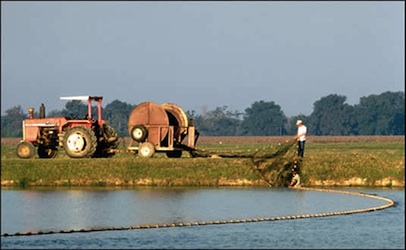The USDA catfish inspection program, first authorized in 2008, is continued in the 2014 farm bill, which also includes a first-of-its-kind “crop insurance” program for catfish farmers.
Most of the so-called political experts were predicting it would go the other way. One paid prognosticator went so far as to suggest that “Southern catfish farmers” were going to be “hooked and filleted” by the new farm bill. But all those who said the USDA catfish inspection program was a goner were wrong.
USDA isn’t saying what happens next. The agency wants to wait for the Senate vote before commenting. President Obama has already said he will sign the farm bill, a product of a House-Senate Conference Committee that is already two years overdue.

Behind every major policy decision in Washington, D.C., there are winners and losers. For this round, the winners are the Catfish Farmers of America, based in tiny Indianola, MS, and the loser is the Virginia-based National Fisheries Institute.
Gavin Gibbons, spokesman for NFI, insisted in the seafood industry’s Undercurrent News that his organization of seafood importers did not lose in the farm bill, but that the USDA’s catfish inspection program repeal language was stripped out by Sen. Thad Cochran (R-MS).
As the ranking Republican on the Senate Agriculture Committee, Cochran was among the handful of leaders who decided what was going to be in the final deal that both the House and Senate would vote on. Like USDA, those working on the farm-raised catfish side also are not talking on the record. It seems likely, however, that Cochran was going to make his play late and that it was going to be big – sort of like the way the Seattle Seahawks win football games. So the 2014 farm bill added crop insurance to the previously won USDA inspection program.
Farm-raised catfish started in 1963 in Mississippi, using old cotton scales to weigh shipments, and with the farmers making sales calls and deliveries directly to restaurants. Finding local bankers willing to loan money for catfish farming, the industry expanded across all the Gulf states through the 1960s and 1970s. Processing plants and innovations followed, and prices for domestic catfish were on the upswing. Then, after five years of negotiations, the U.S.-Vietnam Bilateral Trade Agreement was signed in 2001.
At its peak, which appears to have occurred before it faced the foreign competition, farm-raised catfish reached 600 million pounds annually from about 165,000 pond acres of water.
Before long, U.S catfish was facing competition from Vietnamese fish that first hit the American market with names like “White Roughy” and “River Cobbler.” They followed up, however, with something more consumer friendly — they simply called it “catfish.” To this day, the debate continues over the definition of “catfish.”
The definition is critical to determining if a fish, such as the Vietnamese pangasius, will be subject to USDA inspection. Clearly Vietnam fears that the USDA catfish inspection program is intended as a protectionist trade barrier, and they’re threatening the U.S. with trade retaliation if the program is not repealed. Ever since the USDA inspection of catfish was included in the 2008 farm bill, opponents have argued it is nothing more than a protectionist move being carried out under the veil of food safety.
Ben Pentecost, the Mississippi catfish farmer who is the current president of Catfish Farmers of America, counters by saying that, under the U.S. Food and Drug Administration (FDA), “98 percent of all imported seafood is being served directly to American families with no inspection whatsoever.” But USDA, which had about $20 million to come up with a catfish inspection program, had problems justifying it as a food safety program. On its own power, the department asked the Government Accountability Office for a review and it got back a report calling the USDA inspection program “wasteful and unnecessary.”
But the GAO recommendation was for Congress, not USDA. And the GAO report gave plenty of ammunition to a growing list of opponents, which came to include numerous taxpayer groups, Sen. John McCain (R-AZ), and, of course, the Vietnam embassy. (About 79 percent of the catfish and catfish-like imports are from Vietnam.)
According to figures from early 2013 provided by the National Agriculture Statistic Service (NASS), farm-raised catfish processed during February 2013 totaled about 30 million pounds of round weight.
Imports for January 2013 of catfish and catfish-like species totaled 19.4 million pounds. Imports were from Bangladesh, Brazil, China, the Philippines, Thailand and Vietnam.
U.S. farm-raised catfish is also exported to Canada, China, Kuwait, Mexico, the islands of Turks and Caicos, United Arab Emirates and Vietnam. Fresh catfish fillet exports totaled 377,000 pounds, also for January 2013. There’s been some interruption in NASS data collection due to government budget cutbacks. These figures from 2013 were based on surveys of 17 domestic processors, with wild-capture fish excluded.
“The U.S. farm-raised catfish industry believes imported catfish and catfish-like products should meet the same health and safety requirements as U.S. catfish,” said Pentercost. “We are pleased our farm bill conferees recognized that our U.S. government has a duty to maintain the safety of our nation’s food supply.”
Farm-raised domestic catfish is a low-risk food, according to the federal Centers for Disease Control and Prevention (CDC). GAO’s report contained a risk assessment that questioned whether USDA could make reductions in catfish-associated human illnesses from so low a risk starting point.
With most of the “new” opposition to USDA inspection of catfish being over duplication with FDA, the Cochran language in the 2014 farm bill directs the two agencies to “enter into a memorandum of understanding to improve interagency cooperation and prevent duplicative inspection oversight by ensuring that inspections of dual jurisdiction facilities by the FSIS satisfy the requirements of the FDA.” FSIS is the Food Safety and Inspection Service, USDA’s food safety agency.
The Senate vote on the farm bill is expected on Tuesday.
© Food Safety News





